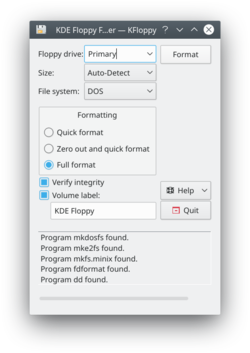KFloppy/es: Difference between revisions
(Updating to match new version of source page) |
(Updating to match new version of source page) |
||
| (2 intermediate revisions by one other user not shown) | |||
| Line 1: | Line 1: | ||
<languages /> | <languages /> | ||
A Graphical Tool for formatting floppy disks | |||
[[Image:Kfloppy2.png|thumb|250px|center]] | |||
==Características== | ==Características== | ||
* Formateado rápido o completo | * Formateado rápido o completo | ||
* Comprobación de sectores defectuosos (verificando la integridad) | * Comprobación de sectores defectuosos (verificando la integridad) | ||
| Line 13: | Line 10: | ||
* Se pueden usar opciones de línea de comandos | * Se pueden usar opciones de línea de comandos | ||
* Compatible con los sistemas de archivos DOS, ext2, UFS y Minix. | * Compatible con los sistemas de archivos DOS, ext2, UFS y Minix. | ||
{{ | ==Usage== | ||
{{Note|A floppy cannot be formatted if it is mounted.}} | |||
* Select the floppy drive which contains the media to be formatted | |||
* Select the size of the floppy to be used. In most cases it is safe to leave this as "Auto-Detect", and should be changed only when encountering size related issues during formatting | |||
* Select a filesystem to be used | |||
** If the desired filesystem is not listed, check the box at the bottom of the window, it may provide a reason | |||
** Not all supported filesystems are usable on floppy disks | |||
* Select the type of format to perform | |||
** Quick Format is as the name implies, the fastest process. It does check for bad blocks or other errors | |||
** Zero out and quick format will overwrite each sector with zeroes. This should not be relied on for securely erasing a disk, only a quick method of destroying data | |||
** Full format will format the media, and check for bad blocks and other filesystem defects if possible | |||
* Check '''Verify Integrity''' if KFloppy is to check if the format was successful | |||
* Provide a name for the floppy, if desired | |||
* Click '''Format''' to format the media | |||
==More Information== | |||
Read about the full capabilities in [http://docs.kde.org/development/en/kdeutils/kfloppy/index.html the application's Handbook] | |||
[[Category:Utilidades/es]] | [[Category:Utilidades/es]] | ||
[[Category:Administración de Archivos/es]] | [[Category:Administración de Archivos/es]] | ||
Latest revision as of 06:50, 26 December 2018
A Graphical Tool for formatting floppy disks

Características
- Formateado rápido o completo
- Comprobación de sectores defectuosos (verificando la integridad)
- Puede etiquetar discos
- Se pueden usar opciones de línea de comandos
- Compatible con los sistemas de archivos DOS, ext2, UFS y Minix.
Usage
- Select the floppy drive which contains the media to be formatted
- Select the size of the floppy to be used. In most cases it is safe to leave this as "Auto-Detect", and should be changed only when encountering size related issues during formatting
- Select a filesystem to be used
- If the desired filesystem is not listed, check the box at the bottom of the window, it may provide a reason
- Not all supported filesystems are usable on floppy disks
- Select the type of format to perform
- Quick Format is as the name implies, the fastest process. It does check for bad blocks or other errors
- Zero out and quick format will overwrite each sector with zeroes. This should not be relied on for securely erasing a disk, only a quick method of destroying data
- Full format will format the media, and check for bad blocks and other filesystem defects if possible
- Check Verify Integrity if KFloppy is to check if the format was successful
- Provide a name for the floppy, if desired
- Click Format to format the media
More Information
Read about the full capabilities in the application's Handbook

